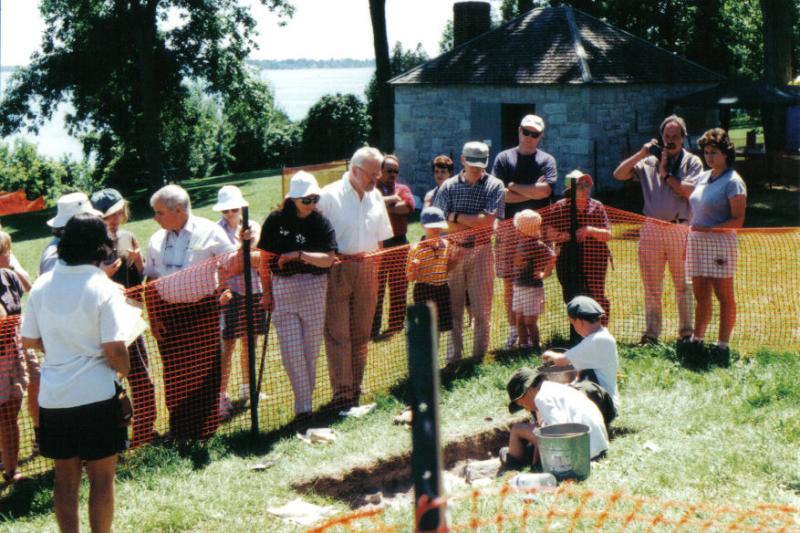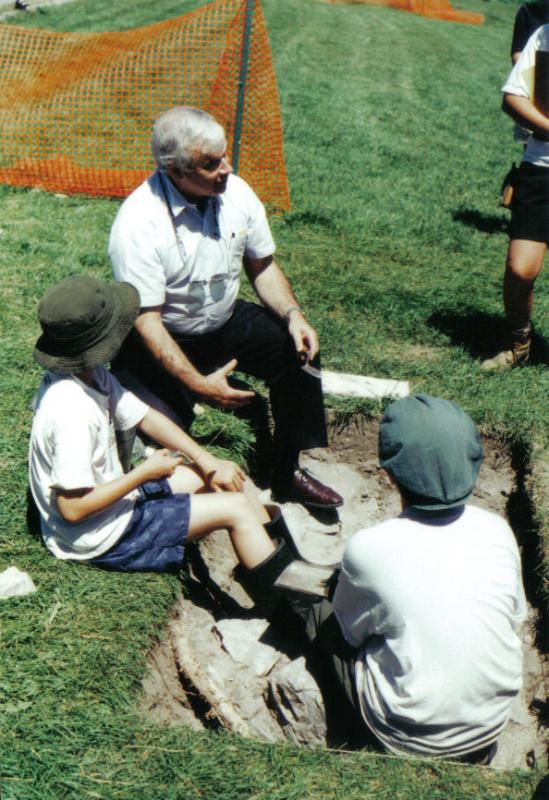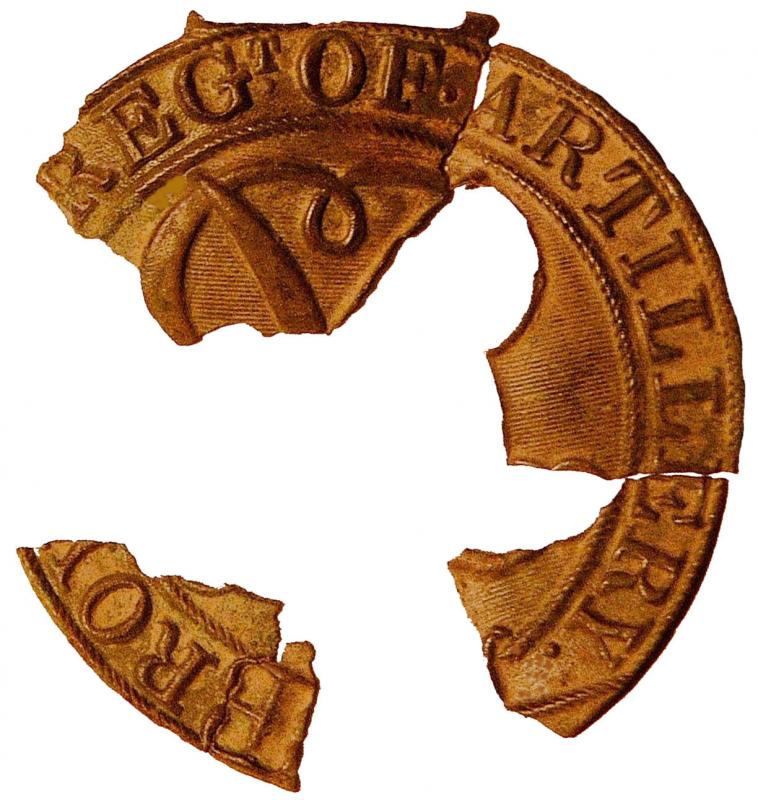 The 2001 excavations revisited the site of the Fort Henry Garrison Hospital on the east side of Deadman Bay, on the St. Lawrence River shoreline of Point Henry. The Garrison Hospital, Guard House and Dead House were once again investigated, building on the 2000 excavation finds and with the aim of locating the actual hospital foundation. The “Can You Dig It?”© Summer Archaeology Program ran from July 10th to September 1st, and had 61 participants. The Focus Program in Archaeology ran for eight weeks from August to September with 12 grade 11/12 students from several high schools. Also a Public Day was held July 25th, and attended by Peter Milliken MP, Councilor Leonore Foster, representatives of Parks Canada and Fort Henry, along with members of the public.
The 2001 excavations revisited the site of the Fort Henry Garrison Hospital on the east side of Deadman Bay, on the St. Lawrence River shoreline of Point Henry. The Garrison Hospital, Guard House and Dead House were once again investigated, building on the 2000 excavation finds and with the aim of locating the actual hospital foundation. The “Can You Dig It?”© Summer Archaeology Program ran from July 10th to September 1st, and had 61 participants. The Focus Program in Archaeology ran for eight weeks from August to September with 12 grade 11/12 students from several high schools. Also a Public Day was held July 25th, and attended by Peter Milliken MP, Councilor Leonore Foster, representatives of Parks Canada and Fort Henry, along with members of the public.
 By 1828, the Fort Henry Garrison Hospital was built on the Point Henry to complement the army’s Regimental or General Hospital located in the town. Its purpose was to serve the detachments barracked at Fort Henry. In 1870 it was converted to barracks, it was ultimately abandoned and remained so through the early decades of the 20th century, and at some point the Dead House was also demolished. The property was then leased to civilians who rapidly populated it with cottages. The hospital building itself remained derelict, and in November 1924 the hospital was destroyed by fire. And with the outbreak of WWII and Fort Henry being used as an internment camp, the fire gutted garrison hospital was deemed a nuisance building and demolished.
By 1828, the Fort Henry Garrison Hospital was built on the Point Henry to complement the army’s Regimental or General Hospital located in the town. Its purpose was to serve the detachments barracked at Fort Henry. In 1870 it was converted to barracks, it was ultimately abandoned and remained so through the early decades of the 20th century, and at some point the Dead House was also demolished. The property was then leased to civilians who rapidly populated it with cottages. The hospital building itself remained derelict, and in November 1924 the hospital was destroyed by fire. And with the outbreak of WWII and Fort Henry being used as an internment camp, the fire gutted garrison hospital was deemed a nuisance building and demolished.
The hospital’s south wall of what was determined to be the south wing was discovered. The ditch, or covered way was also identified as was the north wall of the privy. Large amounts of demolition rubble were noted, but as previously, pre-fire occupation layers were not identified. At the Guard House little additional structural data was collected, but it was apparent that there had been several restoration and maintenance episodes, including that of the 1936-38 restoration. Intensive excavation of the Dead House confirmed that the area had been seriously impacted during the cottage period, and it was determined that a cottage structure had been built on top of the Dead House. This had quite effectively removed all evidence relating to the construction and use of this feature.

Although this may seem like little was discovered, this season did confirm the location of both the Hospital and Dead House Structures. It is now clear that the Dead House was in use for a short period of time and has been essentially removed from the landscape. Interesting artefacts were discovered at the Guard House: ; 43rd and 34th Regiment buttons; Victorian pattern Royal Artillery buttons; and an 1840s penny token. Although little was found to provide further insight into 19th century daily life and activities in the hospital compound, 20th century cottage life was another story! There were relatively large amounts of 20th century ceramics, glass and architectural materials from the occupation and demolition of at least one cottage.

 The 2001 excavations revisited the site of the Fort Henry Garrison Hospital on the east side of Deadman Bay, on the St. Lawrence River shoreline of Point Henry. The Garrison Hospital, Guard House and Dead House were once again investigated, building on the 2000 excavation finds and with the aim of locating the actual hospital foundation. The “Can You Dig It?”© Summer Archaeology Program ran from July 10th to September 1st, and had 61 participants. The Focus Program in Archaeology ran for eight weeks from August to September with 12 grade 11/12 students from several high schools. Also a Public Day was held July 25th, and attended by Peter Milliken MP, Councilor Leonore Foster, representatives of Parks Canada and Fort Henry, along with members of the public.
The 2001 excavations revisited the site of the Fort Henry Garrison Hospital on the east side of Deadman Bay, on the St. Lawrence River shoreline of Point Henry. The Garrison Hospital, Guard House and Dead House were once again investigated, building on the 2000 excavation finds and with the aim of locating the actual hospital foundation. The “Can You Dig It?”© Summer Archaeology Program ran from July 10th to September 1st, and had 61 participants. The Focus Program in Archaeology ran for eight weeks from August to September with 12 grade 11/12 students from several high schools. Also a Public Day was held July 25th, and attended by Peter Milliken MP, Councilor Leonore Foster, representatives of Parks Canada and Fort Henry, along with members of the public. By 1828, the Fort Henry Garrison Hospital was built on the Point Henry to complement the army’s Regimental or General Hospital located in the town. Its purpose was to serve the detachments barracked at Fort Henry. In 1870 it was converted to barracks, it was ultimately abandoned and remained so through the early decades of the 20th century, and at some point the Dead House was also demolished. The property was then leased to civilians who rapidly populated it with cottages. The hospital building itself remained derelict, and in November 1924 the hospital was destroyed by fire. And with the outbreak of WWII and Fort Henry being used as an internment camp, the fire gutted garrison hospital was deemed a nuisance building and demolished.
By 1828, the Fort Henry Garrison Hospital was built on the Point Henry to complement the army’s Regimental or General Hospital located in the town. Its purpose was to serve the detachments barracked at Fort Henry. In 1870 it was converted to barracks, it was ultimately abandoned and remained so through the early decades of the 20th century, and at some point the Dead House was also demolished. The property was then leased to civilians who rapidly populated it with cottages. The hospital building itself remained derelict, and in November 1924 the hospital was destroyed by fire. And with the outbreak of WWII and Fort Henry being used as an internment camp, the fire gutted garrison hospital was deemed a nuisance building and demolished.
